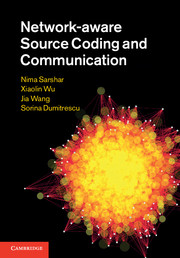4 - Lossless multicast of multiple correlated sources
from Part I - The lossless scenario
Published online by Cambridge University Press: 07 October 2011
Summary
Lossless distributed source coding is a well-studied topic in source communication that has been studied for simple and general cases, with or without network coding. The Slepian-Wolf (S-W) [1] distributed source coding problem considers lossless communication of two discrete correlated sources. More precisely, let X and Y be two correlated sources on a finite alphabet. The S-W problem is to encode X and Y separately to RX and RY bits per source symbol respectively, such that a joint decoder can recover both X and Y without error. As Slepian and Wolf proved in their seminal work [1], such encoding is possible if and only if RX ≥ H(X|Y), RY ≥ H(Y|X) and RX + RY ≥ H(X, Y), where H is the discrete entropy.
As discussed in the introduction, the S-W distributed source coding can be considered as an instance of network source coding for a special network with two source nodes (one for X and one for Y) that are directly connected to a single client. Recently, Ho et al. [3] generalized S-W coding to distributed source coding over arbitrary networks, with an arbitrary number of sources. We start with the simple S-W problem, before reviewing the results for S-W coding on arbitrary networks.
Slepian-Wolf problem in simple networks
Slepian-Wolf theory, also known as distributed data compression, or lossless separate coding of correlated random variables, is a typical source coding problem and belongs to the scope of network information theory.
Information
- Type
- Chapter
- Information
- Network-aware Source Coding and Communication , pp. 25 - 36Publisher: Cambridge University PressPrint publication year: 2011
